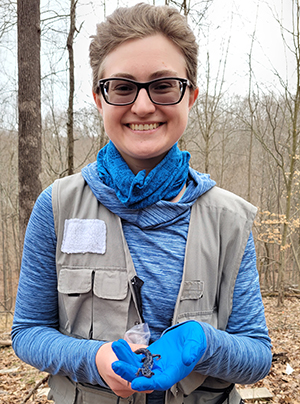 Purdue University - Extension - Forestry and Natural Resources
Purdue University - Extension - Forestry and Natural Resources
Got Nature? Blog
The effects of planting or harvesting a tree often takes time to see. What are the long-term effects on the forest ecosystem as a whole, and also on individual species within it?
A new research publication “Response of Terrestrial Salamanders to the Decade Following Timber Harvest in Hardwood Forests” by graduate research assistant/PhD candidate Alison Ochs along with associate professor of ecology and natural resources Mike Saunders and professor of wildlife science Rob Swihart examined an 11-year span at the Hardwood Ecosystem Experiment to answer that question.
Why study salamander abundance? Salamanders, especially terrestrial salamanders such as

plethodontids, are critical components of forest ecosystems and potential indicators of ecosystem changes due to their broad range, high densities and sensitivity to ecosystem changes. Salamanders rely on cool, moist conditions, which can be affected by the change in available leaf litter and coarse woody debris, as well as canopy cover.
Methods
The Hardwood Ecosystem Experiment is a long-term, large-scale experimental study of forest management and its impact, which began in 2006. The 100-year project aims to find the ecological and social impacts of long-term forest management on public and private lands in Indiana and the Central Hardwood Region. The HEE features nine units located across the Morgan-Monroe and Yellowwood State Forests, which were analyzed prior to timber harvesting and the years following timber harvests. Units were assigned to utilize even-aged management, uneven aged management or as unharvested controls.
“With salamanders and other amphibians on the decline, understanding how timber harvest affects these vulnerable species is critical,” Ochs said. “Our findings suggest that timber harvesting techniques that keep some canopy cover may help prevent salamander declines, and even help protect them from drought, a concern as such extreme weather events are growing more common. These findings may be useful to land managers who hope to conduct timber management sustainably without damaging delicate ecosystems and species. Land managers particularly concerned about salamander populations may consider using methods such as shelterwood harvesting rather than more impactful clearcutting.”
Data was collected using artificial cover object grids beginning in the fall of 2007 to determine relative salamander abundance. The first harvests occurred in the winter of 2008. Data was collected in the fall (from mid-September to mid-November) and the spring (from the beginning of March to the end of April) each year through November 2014. Sampling then took place from the fall of 2015 through the spring of 2017 and paused, before resuming in March 2019.
Researchers utilized R for statistical computing and used a before-after-control-impact (BACI) design to examine the effects of harvest type on salamander captures with generalized linear mixed effects models.
Resources:
Hardwood Ecosystem Experiment (HEE), Playlist, Purdue Extension – Forestry and Natural Resources
Hardwood Ecosystem Experiment, Website
Hardwood Ecosystem Experiment – Wildlife Responses to Timber Harvesting, The Education Store, Purdue Extension – Forestry and Natural Resources
The Hardwood Ecosystem Experiment: Indiana Forestry and Wildlife, The Education Store
A Moment in the Wild, Playlist, Purdue Extension – Forestry and Natural Resources YouTube Channel
Improving Water Quality by Protecting Sinkholes on Your Property, Video, Purdue Extension – FNR YouTube Channel
Question: Which salamander is this?, Got Nature? Blog, Purdue Extension – Forestry and Natural Resources
Is it a Hellbender or a Mudpuppy?, Got Nature? Blog
Amphibians: Frogs, Toads, and Salamanders, Purdue Nature of Teaching
Wendy Mayer, Communications Coordinator
Purdue University Department of Forestry and Natural Resources

Recent Posts
- Hardwood Tree Log and Lumber Quality Workshop
Posted: May 10, 2024 in Forestry, Forests and Street Trees, How To, Woodlands - Take Your Turkey Fun Further – Wild Bulletin
Posted: May 9, 2024 in Forestry, How To, Wildlife - Paddle for Data – Wild Bulletin
Posted: in Aquaculture/Fish, Great Lakes, Ponds, Wildlife - IISG Adds New Water Safety Videos
Posted: May 8, 2024 in Aquaculture/Fish, Aquatic/Aquaculture Resources, Community Development, Great Lakes, Wildlife - Invasive Bradford-Callery Pear: Why it is so detrimental and what to plant instead
Posted: in Forests and Street Trees, How To, Invasive Plant Species, Urban Forestry - Trees and Storms – Mitigating the Damage
Posted: May 7, 2024 in How To, Urban Forestry - New Indiana Woodland Steward Newsletter, Your Forest and Wildlife Resource
Posted: in Timber Marketing, Wildlife, Woodlands - Farmers Helping Hellbenders RCPP Program Accepting Applications
Posted: May 1, 2024 in Aquaculture/Fish, Forestry, How To, Wildlife, Woodlands - Extension Specialist Brian MacGowan Receives Hoosier Wildlife Award
Posted: in Forestry, Wildlife - MyDNR – First positive case of chronic wasting disease in Indiana
Posted: April 29, 2024 in Alert, Disease, How To, Safety, Wildlife
Archives
Categories
- Alert
- Aquaculture/Fish
- Aquatic/Aquaculture Resources
- Ask the Expert
- Christmas Trees
- Community Development
- Disease
- Drought
- Forestry
- Forests and Street Trees
- Gardening
- Got Nature for Kids
- Great Lakes
- How To
- Invasive Animal Species
- Invasive Insects
- Invasive Plant Species
- Land Use
- Natural Resource Planning
- Nature of Teaching
- Plants
- Podcasts
- Ponds
- Publication
- Safety
- Timber Marketing
- Uncategorized
- Urban Forestry
- Webinar
- Wildlife
- Wood Products/Manufacturing
- Woodland Management Moment
- Woodlands